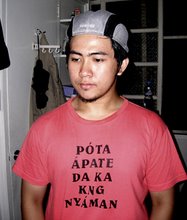The Kapampangan Polosador
The proliferation of Kapampangan polosa and basulto CDs is both boon and bane to Kapampangan culture -- boon, because at least the songs help promote the language and popularize a traditional Kapampangan musical genre; and bane, because most of them have bad production values, have been pirated, and give the impression that Kapampangan music is all novelty and bawdy.
After Sapni nang Crissot, Cris Cadiang, Arti Sta. Rita, and Mon David produced their respective CDs which reminded us how beautiful and sublime Kapampangan music used to be and can still be, Totoy Bato and other polosador (or mamulosa) followed suit but since they lacked access to funding and recording studios, recorded their performances under the worst possible recording environment and using probably no equipment other than a cassette recorder. Someone later burned this on CD and distributed copies to sidewalk vendors, most likely without the knowledge or permission of the performers, who got no payment and will collect no royalties.
The music of Totoy Bato is interchangeably called as polosa and basulto. According to one polosador, polosa is defined by its content and basulto by its beat.
Polosa is a tribute; thus, a polosador is someone who sings in honor of a birthday celebrator, a guest of honor, a guest speaker, or a newly crowned beauty queen. The polosa is sung extemporaneously, and this is where the genius of a polosador comes out: all he needs to do is take a quick look at the honoree, or get a quick interview with him, and the next moment he is already singing praises to his looks and his accomplishments in life.
Basulto, on the other hand, refers to all Kapampangan songs sung with a fast beat, similar to the yodeling style of Fred Panopio (who is a Kapampangan from Bacolor) and to ditties performed by guitar-toting door-to-door beggars; papalatuk la tonu is a good description.
The word polosa is probably a corruption of prosa, or prose, which is the opposite of poesiya, or poetry. In the early days, people considered poetry "the language of angels" and prose "the language of men," i.e., appropriate for the masses, not for the upper class.
Totoy Bato, who in real life is Rodolfo Laxamana of Tokwing, Porac, is the known Kapampangan singer in Pampanga today. I have to qualify "in Pampanga" because I doubt if he is as popular outside the province as, say, Mon David, but here, among his kabalen, Totoy Bato has achieved cult stature. In fact, his name is already generic: anyone who sings in Kapampangan is a Totoy Bato.
Fellow polosador Ruth Lobo complains he is often introduced as Totoy Bato. And then there are two or three other singers who go by the name of Totoy: Totoy David of Potrero, Bacolor; Totoy Negro (or Totoy the Third) of San Pablo, Guagua; and then there are those who go around claiming to be the original Totoy Bato so that they could collect advance payment for singing engagements. These extortionist activities of his alter egos have embarrassed, infuriated and sometimes got the original Totoy Bato into trouble.
Because they are vanishing breed, Kapampangan polosador can dictate their own price. For a 30-minute to one-hour live performance in a program or private party, they charge P6,000.00, which is reasonable considering they bring their own guitarist who brings along his own sound system. If they perform beyond one hour, they charge P8,000.00.
If it's the mayor inviting a polosador to a townfiesta (variety show, or "jamboree"), it's usually a package deal in which the polosador brings along an entourage of 12 people composed of comedians, poets, dancers, the emcee and of course, two or three polosador and the guitarist. They take care of the entire show (usually lasting no less than five hours) and they charge P27,000.00, each getting about P1,500.00 (Totoy Bato, the star of the show, getting P2,000.00).
During this campaign season, politicians get the services of polosador not only to perform during rallies but also to compose campaign jingles. For six different jingles (original lyrics, borrowed music), a polosador charges P8,000.00 to P10,000.00, including the singing and recording.
The ditty is usually brief and repetitive, sung to the tune of whatever tune is popular at the time. Example: Daratang ne naman/Aldo ning alalan/Magbotu tana/Agkatan da ko ngan/Ikong kabaryu ku/keni manuknangan/ Robin Nepomuceno/Atiu ne't daratang.
Nowadays, some polosador resort to undignified ways of soliciting public attention and funding. They volunteer to perform in programs, only to be turned away. They use bawdy lyrics to elicit audience response. The worst indignity of all is when they have to haggle the price of their talent which, when you come to think of it, is more valuable than the rarest gem.
A polosador is a living legend, a survivor from the golden age of Kapampangan literature. Even if they act in a less than dignified way, due to poverty, we should treat them with respect and gratitude, because instead of making a living for their family, they chose the spend the rest of their lives singing the songs of our ancestors and keeping our Amanung Sisuan alive in the hearts and minds of our kabalen.
I would like to end this article by enumerating the names of the last of these great folk minstrels as a way of honoring them:
- Totoy Bato (Rodolfo Laxamana) of Tokwing, Porac
- Ruth Lobo of Pulungbulu, Angeles City
- Joker Villamor of O'Donell, Capas
- Bong Manalo of Bacolor (now Bulaon Resettlement)
- Totoy David of Potrero, Bacolor (now Madapdap Resettlement)
- Monching Basilio of Potrero, Bacolor (now Pandacaqui Resettlement)
- Rico Dizon of Magalang (Monching and Rico together are known as Pusoy Dos)
- Rene Reyes of Bagumbayan, Angeles City
- Rodolfo Basilio of Potrero, Bacolor (now Pandacaqui Resettlement)
- Jimmy "Bini" Baul of Pulung Masle, Guagua
- Totoy Negro (or Totoy the Third) of San Pablo, Guagua
- Al Angeles of San Jose, Angeles City
- Luisa Macapagal of San Luis
- Lina Agorto Bautista of Mabiga, Mabalacat; Renie Salor of Cutcut, Angeles City
- Rommel Basulto of Cutcut, Angeles City
- Milo Valencia of Tokwing, Porac
- guitarist Oca Esguerra of Mabalacat (now Amsic, Angeles City).
End of article.
Actually, I personally tried to tap young Kapampangan music makers (rock, acoustic, and alternative bands) to keep the art alive by composing new basultos and polosas. Not everyone was interested, of course, since some of these so-called "Kapampangan bands" can't even speak Kapampangan, making them apathetic of the language deterioration issue. Understandable. Yet sad.
However, there are those who became interested and -- not only that -- shared sentiments regarding the Kapampangan rock scene being left behind by the Chavacanos of Zamboanga, the Davawenyos, and the ever-shining Bisaya Rockers (Cebuano). Oh, Tagalog rockers, too, duh.
KAMARU is planning to head a project that would support these dayang kua musicians, and at the same time keep basulto and polosa alive and un-alien to the current generation. Maybe if new Kapampangan songs were born, radio stations in Pampanga would finally air Kapampangan music. We'll work on it.
Actually, I personally tried to tap young Kapampangan music makers (rock, acoustic, and alternative bands) to keep the art alive by composing new basultos and polosas. Not everyone was interested, of course, since some of these so-called "Kapampangan bands" can't even speak Kapampangan, making them apathetic of the language deterioration issue. Understandable. Yet sad.
However, there are those who became interested and -- not only that -- shared sentiments regarding the Kapampangan rock scene being left behind by the Chavacanos of Zamboanga, the Davawenyos, and the ever-shining Bisaya Rockers (Cebuano). Oh, Tagalog rockers, too, duh.
KAMARU is planning to head a project that would support these dayang kua musicians, and at the same time keep basulto and polosa alive and un-alien to the current generation. Maybe if new Kapampangan songs were born, radio stations in Pampanga would finally air Kapampangan music. We'll work on it.







